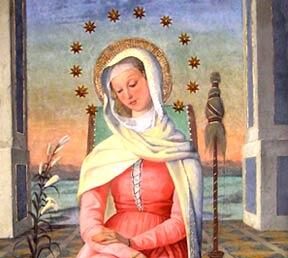The BFN Province has created a series that presents the life and work of Madeleine Sophie and invites us to follow her bold example. Read the supplementary article that talks about the Feast of Mater Admirabilis.
October 20: The Feast of Mater Admirabilis
At a community meeting in May, 1844, one of the nuns exclaimed: “Ah! If only the Blessed Virgin would deign to come and preside over our meetings! Hearing this, Pauline Perdrau, a young postulant in the Society of the Sacred Heart, decided to bring Mary into the midst of the community by painting her in a fresco on the wall of the first-floor corridor where they were meeting. Pauline was inspired by an image close to her heart: the Virgin in the temple, spinning wool, a sign of patience and perseverance. This painting, first called “the Virgin of the Lily”, inspired passers-by to pray. When Pope Pius IX visited the Trinità dei Monti in the first year of his pontificate, he blessed the fresco and gave it the name “Mère admirable”, or “Mater Admirabilis”, by which it is now known and attracts visitors. Pope Pius IX came twenty-one times to Trinità dei Monti to visit the little Madonna to whom he was so attached. He authorized masses to be celebrated in front of the fresco, and the corridor where it is painted was transformed into a chapel. Numerous healings associated with her prayers are attested as early as 1846, and many conversions have taken place in front of this fresco. The ex-votos on the walls bear witness to the graces received. Many saints and faithful have come to pray here. The image of the fresco is reproduced in every Sacred Heart school. Even today, many students, of whom she is the patron saint, and alumni from all over the world contemplate and pray to Mater Admirabilis. The devotion to her extends beyond the wide network of Sacred Heart students, as the fresco is reproduced in countless churches, monasteries and seminaries.
For prayer
“In the sixth month, the angel Gabriel was sent from God to a town of Galilee called Nazareth, to a virgin betrothed to a man named Joseph, of the house of David, and the virgin’s name was Mary. And coming to her, he said, ‘Hail, favored one! The Lord is with you.’ But she was greatly troubled at what was said and pondered what sort of greeting this might be. Then the angel said to her, ‘Do not be afraid, Mary, for you have found favor with God. Behold, you will conceive in your womb and bear a son, and you shall name him Jesus. He will be great and will be called Son of the Most High, and the Lord God will give him the throne of David his father, and he will rule over the house of Jacob forever, and of his kingdom there will be no end.’
“But Mary said to the angel, ‘How can this be, since I have no relations with a man?’ And the angel said to her in reply, ‘The holy Spirit will come upon you, and the power of the Most High will overshadow you. Therefore the child to be born will be called holy, the Son of God. And behold, Elizabeth, your relative, has also conceived a son in her old age, and this is the sixth month for her who was called barren; for nothing will be impossible for God.’
“Mary said, ‘Behold, I am the handmaid of the Lord. May it be done to me according to your word.’ Then the angel departed from her.” (Luke 1, 26 – 38)
“Hail, favored one! The Lord is with you”: This is a strange way to begin a relationship! Slowly take up the greeting itself, the name given to Mary, the announcement of God’s presence in her life…what does this awaken in me? What names do I give to the Lord’s mother?
“Behold, you will conceive in your womb and bear a son”: Mary’s desire is to bear life. How does God inhabit and transform her project? What is my plan for the future? Does God intervene in my choices?
“Nothing will be impossible for God”: God showed this with Elisabeth, Mary’s cousin, who, against all odds, became pregnant. Who is God for me, so that I dare to trust Him?
From the writings
“On June 1, 1844, the fresco was begun. I began, following the advice of the fresco mason who, every morning, came to spread on the wall the piece of lime he had prepared and which I was to cover with paint during the day. (…) The frescoes were painted in very dark tones that only took on their true light and color when they dried, after twenty-five or thirty days. So when the whole community saw a poor figure covered in red skin, wearing a dark red dress and a canary yellow coat… they remained silent, a charitable but discouraging silence. My fresco was finished, frightening everyone except my dear mason who told me: “Superb, it’s a fresh flower, a jewel, you’ll see!”. I thought it prudent to nail a sheet in front of the niche while it dried (…) after fifteen days, she had become the lily of the valleys, the flower of the fields!” (Pauline Perdrau’s account, May 6, 1862)
“I see you’ve occupied your trial months at the convent studying fresco painting, and your little Holy Virgin in the corridor isn’t bad at all….on my way to the gallery, I often turn my head to look at it; it attracts me; it’s the same age as our pupils and speaks to me of the young people to whom I have dedicated my life for the love of the Heart of Jesus” (Remarks by Madeleine-Sophie to Pauline Perdrau, then a postulant at the Trinità dei Monti convent, RSCJ, Les loisirs de l’abbaye).
“Under the pressure of over activity which at times consumes us, disturbs us, or scatters our energies in doing what is visible and accidental, let us come to our “Mater.” She is the Mother of the Invisible, and the Mother of the Essential. Let us ask her to detach us, to free us from all that is not important, to lead us on, and fix our gaze upon the Invisible which her own eyes look upon: the Invisible Presence, the Invisible Life; the Invisible Action: the Invisible Love (…) May Mater give us the singleness of vision so that we, too, may see the Invisible and Essential in all.” (Circular letter from Marie-Thérèse de Lescure, Superior General, 1946-1957).
Today
This representation of Mary is present in Sacred Heart schools around the world, and she is celebrated as the patron saint of students on October 20. Reproductions can also be found in families and churches (for example, on the Place Notre-Dame-la-Grande in Poitiers, in the Bonne Mère church in Marseille).
Photo caption: Trinità dei Monti, Rome
Prayer of Mère de Lescure
Admirable Mother,
treasure of calm and serenity,
we love you for the light of your downcast eyes,
for the peace of your face,
for the attitude that reveals
your inner fullness.
You are the Virgin of the invisible and the essential.
We beg you to detach us,
from all that can be seen
to bring us back and fix us
on the invisible that your eyes look upon:
the invisible presence, the invisible life,
the invisible action, the invisible love.
In our busy, overloaded days,
keep us in the light of things
that cannot be seen.
Through the accessory that often solicits
and seduces us
give us also
the sense and the hunger for the essential.
(Marie-Thérèse de Lescure, Superior General)
An invitation
Take time to silently contemplate this image of Mary as a young girl:
- What moves me / pleases me? What surprises me? What does this figure provoke in me?
- What does it speak to me of (for example, trust, patience) and what prayer would I like to address to Mary? Or to the Lord?
Songs & music
- Song for Mater Admirabilis
“Mater Admirabilis
Full of light and beauty
called to be the Mother of God
Chosen from all women”
- Mater Admirabilis – Dei Amoris Cantores
Section |History|International News
Province |Belgium/France/Netherlands
Our Spirituality |Reflections from Around the World|The Sacred Heart Spiritual Tradition
Tags |Madeleine Sophie|Magdalena Sofía|Mater Admirabilis|Saint Madeleine Sophie Barat|Sainte Madeleine Sophie Barat|Santa Magdalena Sofía Barat



